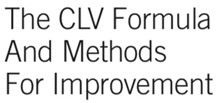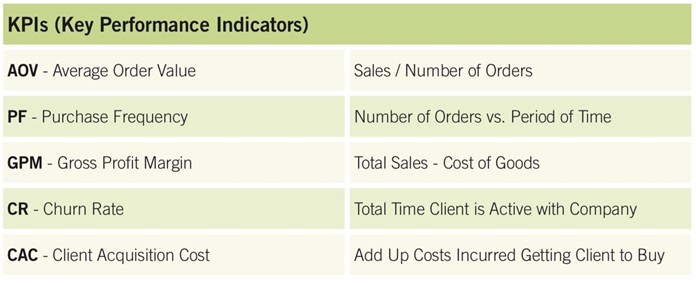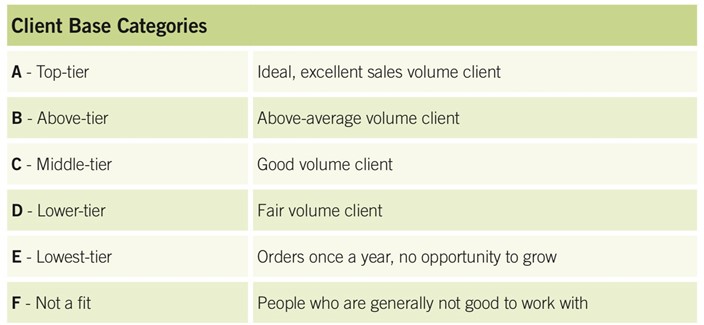The Client's Lifetime Value: A Critical Metric For Success

bsd studio / Djomas / Zerbor / Shutterstock.com
To explain it simply, a client’s lifetime value or CLV represents a customer’s value to a business over a period of time. CLV is also a statistical formulation of either historic or predictive data. With this definition, you can see how by understanding your clients on a deeper level you can put the pieces together to get a solid valuation on your clients. Then, you can take that data and use it to target the right prospects while maintaining your current clients.
––––––––––––––––––––––––––––––––––––––––––––––––––––––––––––––––––––––––––

Knowing your CLV gives you a strong reference point for the clients to keep, by evaluating their short and long-term value to your company. With my marketing company, I realized this valuation helped me manage my time, gave me a clear picture of who to target and where to allocate my marketing dollars in the most effective way.
A company’s marketing budget is limited. For example, I earmark four to six percent of sales for my marketing budget. How do you allocate those dollars? Studies show it is six times more costly to acquire than to retain a client. Once you bring the ideal client into your portfolio, doesn’t it make sense to nurture and maintain the relationship?
Remember, you have 24 hours in a day and those hours need to be broken down into various silos: parent and spousal duties, taking care of yourself and your family. Then, the business comes into play and depending on your bandwidth, the time you must work on your business must be used efficiently.
––––––––––––––––––––––––––––––––––––––––––––––––––––––––––––––––––––––––––

There are two types of CLV, historic and predictive:
Historic – This type refers to the information you currently know about your existing clients and the data you can analyze, including year-to-date sales, average order size, number of orders, profit, average profit per order, average gross profit and length of time of relationship.
Predictive – These are numbers you can project, based on the historical data and your experience with the client to extrapolate the long-term, projected valuation. For instance, if a company, in the first six months, generates $30,000 in sales, one could speculate the client will generate $60,000 over the course of the year. If your clients stay with your company an average of eight years, you could extrapolate the client would potentially be worth $480,000. Knowing this information will better assess acquisition costs.
––––––––––––––––––––––––––––––––––––––––––––––––––––––––––––––––––––––––––

Below are some suggested KPIs (Key Performance Indicators) to track and measure for continuing to assess the value of your clients.
AOV – Average Order Value is sales divided by number of orders. A couple of ways to improve AOV is to use suggestive selling: packaging, kitting, fulfillment, company stores, print management, programs, awards and accessorizing.
PF – Purchase Frequency means the number of orders placed by a client over a period of time. Improvement methods include deep dive reports that look at the prior year’s purchases. Also, send reminders, create prototypes, and virtual, speculative and over-run samples.
GPM – Gross Profit Margin is figured with this calculation: Total sales - Cost of Goods = Gross Margin. Methods to improve GPM include looking at additional value-added services. Stop looking at promotional codes and, instead, get paid for your creativity, value-added accessorizing, packaging, kitting, fulfillment and creative marketing campaigns.
CR – Churn Rate means the length of time a client remains active with your company. Improve CR by staying engaged with clients, creating a relevant and consistent touch program, creating an ongoing positive client experience, suggestive selling and forwarding information other than sales-related material that fosters engagement.
CAC – Client Acquisition Cost is the cost of getting a client to buy your goods and services. To improve the CAC, manage your marketing efforts, know your costs, know your personal hourly rate, track expenditures, focus on the right clients that are high-volume and high profit, and scale your marketing efforts. The key is to reduce costs here, without sacrificing the quality of the messaging and your engagement efforts.

––––––––––––––––––––––––––––––––––––––––––––––––––––––––––––––––––––––––––

You can improve your CLV by classifying and segmenting your current clients to determine who your ideal clients are when prospecting and only target those who fit your criteria. When deciding on your specific marketing efforts, make sure they are scalable, use a variety of marketing channels and develop new internal strategies to connect. Lastly, be meticulous regarding your numbers; know your numbers and budget and forecast appropriately.
––––––––––––––––––––––––––––––––––––––––––––––––––––––––––––––––––––––––––
![]()
Long ago, I made a significant internal change which markedly changed my business. I separated my client list by vertical markets and classified each company into manageable channels according to the A-F categories below. There are many types of criteria; here are the ones I use: sales volume, profitability, opportunity to grow, openness of the client, communication, disposition, accounts receivable collectability, and if the client refers business to you.
A Top-tier, or your ideal, excellent sales volume client
B Above-average volume client
C Middle-tier, good volume client
D Lower-tier, fair volume client
E Lowest-tier volume client; like orders once a year, fits all other criteria, no opportunity to grow
F These are clients that no longer fit the criteria because they are bad payers, horrible communicators, always bid out projects, never refer clients and, in general, are not good people to work with. These types I would eliminate from my client base and not take another order from them. It’s a tough call, but a necessary one.
I evaluate my clients every quarter and adjust where they were on my classification scale, as this process ties in directly with my marketing efforts.

––––––––––––––––––––––––––––––––––––––––––––––––––––––––––––––––––––––––––
![]()
By breaking down my clients by vertical markets I can run reports to see which vertical markets are performing best. This allows me, when prospecting, to only target A/B type clients in my top five vertical markets. Additionally, my marketing dollars are allocated in an 80/20 scale, with 80 percent dedicated to existing clients and broken out proportionally to my A-E listed clients, and the 20 percent is allocated to prospecting, but as stated, only to A/B type clients within those top five vertical markets.
––––––––––––––––––––––––––––––––––––––––––––––––––––––––––––––––––––––––––

Customer Experience – Invest in customer experience by having an engaging interactive website. Have a relevant, engaging social media presence. Look at client portals, surveying their relevant, regular and consistent marketing; consider staying connected using video.
Loyalty Programs – While these can be effective, be mindful of transparency and ask the question if the client can participate. Consider developing company stores with premium products and services that you can use by sending clients reward codes to redeem them.
Recognize And Reward – Offer a client of the month program, or perhaps you could develop a program whereby a percentage of their sales (when they reach certain thresholds) could be donated to a charity of their choice.
Close The Loop – Be proactive in your efforts, survey your clients, practice active listening and ask about improvements you could make that would enhance the client experience.
Remember: Statistically, it is six times more costly to acquire a client than to keep one. Once you win them and if they are a great client, do everything you can to retain them.
––––––––––––––––––––––––––––––––––––––––––––––––––––––––––––––––––––––––––
![]()
Over the years, I have made numerous mistakes, however, once I implemented this internal system and developed this strategy, it gave a huge boost to my business. When I finally knew on a deeper level who my ideal clients were, it allowed me to focus on those clients and to retain them long term.
If you develop a sound strategy which will balance your sales portfolio, you will find you will have better sales, stronger loyalty, higher profits and clients who will stick around for years and years.
––––––––––––––––––––––––––––––––––––––––––––––––––––––––––––––––––––––––––
![]()
If you choose, down the road, to sell your business, having a system where you can show consistent growth, maximum engagement and sound profits will demonstrate to a potential buyer that you have a strong business strategy, and it will make your business more appealing.
––––––––––––––––––––––––––––––––––––––––––––––––––––––––––––––––––––––––––
![]()
Identify the CLV by going through the formulas outlined in this article and develop a baseline understanding. Identify and vertically segment your current base, then classify them as A-F, dump the deadwood and begin the process.
Knowing the CLV will allow you to manage your clients and time, develop more balanced marketing strategies, forecast and budget more effectively, and build the most robust, profitable business possible.
––––––––––––––––––––––––––––––––––––––––––––––––––––––––––––––––––––––––––
Cliff Quicksell, Jr., MAS+, president of Cliff Quicksell Associates, has been an active industry volunteer serving on various PPAI committees, as a speaker and facilitator at PPAI and ASI shows, and as a member of PPAI’s Ambassadors Speakers Bureau for more than 15 years. He has also served five terms as the education chairperson for Chesapeake Promotional Products Association and is currently board president.
Quicksell has also been a speaker, trainer and international consultant to companies, associations and international business groups for more than 34 years and is the recipient of numerous awards including 30 PPAI Pyramid Awards and is a five-time winner of the Printing Industry PSDA’s Peak Award for creativity and the CPPA Creativity PEAKE Award. He was PPAI’s Ambassador Speaker of the Year for six consecutive years and, in 1997, was the inaugural recipient of PPAI’s Distinguished Service Award. Counselor magazine named Quicksell one of the Top 50 Most Influential People in the Promotional Products Industry. Quicksell will be inducted into the PPAI Hall of Fame in January 2022.
He writes two weekly blogs, “Jumpstart Monday” and “30 Seconds to Greatness.” Reach him at cliff@quicksellspeaks.com and www.quicksellspeaks.com.

